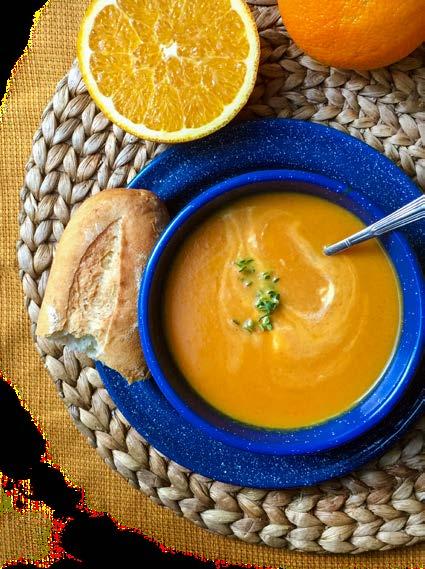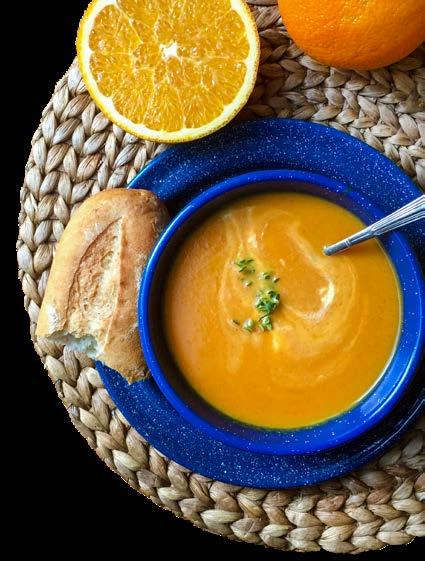
5 minute read
COOKING MY WAY HOME
Exploring the Sunny Ways of Citrus
BY REBECCA HOWARD
Rebecca Howard I WAS ONCE BLESSED with living in a rental house in Northern California that included both an orange tree so large it shaded the backyard and a compact, yet fruitful Meyer lemon, which, lacking citrus knowledge, I mistakenly at first called a “minor” lemon.
The orange tree was so abundant, I didn’t mind sharing with the squirrels, who dropped peelings from their snacking positions in the leaves and left what appeared to be whole oranges on the ground, completely hollowed with a squirrel face-sized hole in them.
The lemon, too, was packed with the ultra juicy, floral-flavored lemons. It was worth gouging myself and dodging flocks of tiny birds that nested in the thorny, hedge-like tree.
The indulgence of having a constant supply of fresh tart-sweet citrus had me turning a corner from which I could never return. I was soon zesting and squeezing with a fervor, making everything from fresh lemonade to cakes flavored with orange rind infused in buttermilk.
I still grow Meyer lemons (they have a rare and limited availability in the grocery stores), which are sweeter than the more commonly found Eureka or Lisbon. I even gifted my mother a pair of dwarf Meyer lemon trees, which she kept alive and fruiting in pots she transported inside to winter in her sunny dining room. I’ve been accused of putting citrus zest in everything (almost true, but I draw the line where it is incompatible), and while this may seem crazy, if you’ve never had pancakes with ricotta and lemon zest, you should not judge. I do see limitless possibilities with lemons, from squeezing them in warm water I drink every morning (a healthful habit I developed several years ago), to making sweet citrus curd to spread on scones, to adding slices atop salmon I bake in foil packets. Winter to early spring is peak season for lemons, limes, oranges (with varieties ranging from diminutive clementines to plus-sized Sumo) and grapefruit. The sunny citrus abound this time of year, but I do think many people wonder what to do with these sweet-and-sour fruits.
Aside from adding a needed dose of vitamin C to cooking and baking, citrus adds bright flavor. Just a little can sometimes make the difference between good to great taste. And one should be open to some unexpected possibilities. A carrot soup I recently made (I’ve shared the recipe here), flavored with orange juice and zest, was so tasty it took me by surprise and made me a fan.
So, if you’ve got lemons (or limes, oranges and grapefruit), you can make lemonade or … LEMON: Keep a bowl of this versatile citrus on your counter. For cleaning alone (cutting boards, microwave, garlicky hands), they work wonders. Carrot-Orange Soup f 1 pound carrots, peeled and thinly sliced f 1 medium onion, diced f 6 garlic cloves, chopped f 1 2-inch piece fresh ginger, peeled f 3 Tbs. olive oil or vegetable oil f 1 large sprig fresh thyme, plus more for garnish f 1/2 tsp. dried thyme f 1 large orange f 4-1/2 cups reduced-sodium vegetable stock (or chicken stock) f Salt and pepper f 1/4 cup sour cream or plain yogurt Heat oil in a large saucepan over medium heat. Add carrots, onions, garlic and ginger and cook, stirring occasionally, until onion is golden and vegetables are beginning to soften, about 8 minutes. While vegetables are cooking, grate orange to get about 2 tsp. of zest. Juice orange to yield about 1/2 cup of juice. Add thyme (fresh and dried, see note), orange zest and stock to sautéed vegetables. Bring to a boil, then reduce heat to medium-low, cover the saucepan and cook until carrots are tender, about 20 minutes. Using an immersion blender or, working in batches, a traditional blender or food processor, puree soup until smooth. Return to the saucepan, add the orange juice and salt and pepper to taste. Cook over medium heat until heated through, about 2 minutes. Garnish each bowl of soup with a dollop of sour cream or yogurt and a sprinkling of fresh thyme leaves. Makes 4 servings. NOTE: If you cannot find fresh thyme, using just dried will do. If you cannot find fresh ginger root, substitute a small amount (1/4 tsp) of dried ginger when adding the thyme. You can also garnish the soup with chopped chives or scallions or additional orange zest. Makes 4 to 6 servings.
Try zest of lemon (or lime or orange) to make flavored salts and sugars or spice rubs and dry brines or marinades. Toss chopped potatoes with olive oil, lemon juice and zest and salt and pepper for lemony-roasted potatoes. Lemon adds zip to any seafood or roast chicken, but also to beef dishes (try a squeeze of lemon on steak) or as a finish to a pot of beans. Juice lemons (or other citrus) and freeze the juice in ice cube trays to add to cooking later or to serve as chilling flavors for ice teas, lemonade and punch. LIME: You can put the lime in the coconut, but it also goes well with anything from cherries to watermelon. And have you tried it with roasted corn or corn on the cob? Lime pairs nicely with any Mexican dish. Squeeze some as a bright finish to black bean soup. Lime juice works well with pickles (or other pickled items). Fruit salads can benefit from both lime zest and juice. And if you like lemon bars, try lemon-lime! GRAPEFRUIT: Add segments to spinach salad or mix into yogurt. Grapefruit also pairs well with dishes featuring shrimp or avocado. Add a squeeze of grapefruit juice to homemade salad dressings calling for citrus. Slice peeled grapefruit thinly, drizzle with a simple ginger-sugar syrup and top with vanilla ice cream. Stew chopped fruit and rind (or a mix with oranges) for homemade marmalade. A sweetened grapefruit juice syrup can be frozen and turned into a refreshing granita. ORANGE: Use orange in baking recipes that call for lemon, like pound cake, cheesecake or blueberry muffins. Orange juice and rind make


beautiful salad dressings and glazes for vegetables, like carrots or green beans. Squeeze a little orange over baked or roasted sweet potatoes. Orange also adds a nice flavor to meat sauces, adding real zing to barbecue sauce. KCL
REBECCA HOWARD grew up in Kansas and has written for the Los Angeles Daily News, the Los Angeles Times and LA Parent Magazine, and currently writes the food blog, “A Woman Sconed.”








